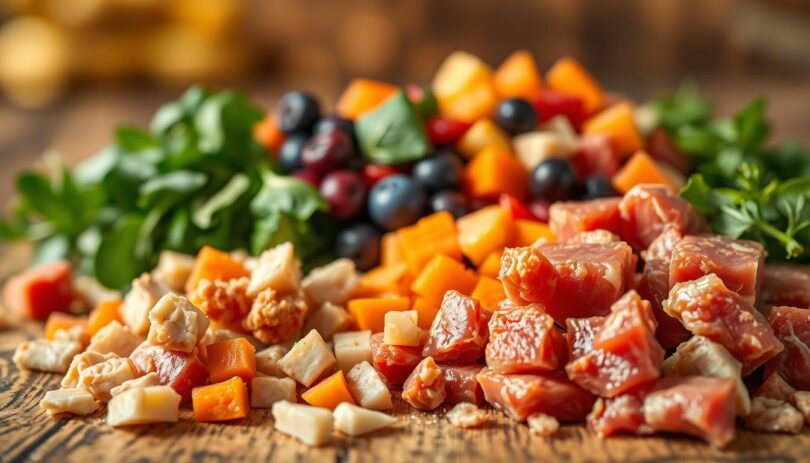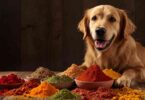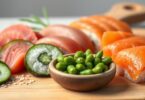Did you know 34% of pet owners who switched to uncooked meals for their pets saw visible health improvements within six weeks? This approach, inspired by ancestral eating habits, has gained traction among modern caregivers seeking natural alternatives for their furry friends.
Unlike traditional kibble, this method focuses on fresh, minimally processed ingredients like muscle meats, organs, and crushed bones. Advocates suggest it mirrors what canines might consume in the wild, potentially supporting digestion and vitality. Recent studies highlight noticeable changes in coat shine and dental cleanliness for many animals making the switch.
While concepts like the BARF (Biologically Appropriate Raw Food) framework have existed since the 1990s, today’s pet parents are increasingly curious about its practical applications. Our complete guide to raw feeding breaks down everything from portion sizes to safety protocols, helping you make informed choices.
This article explores both the science and real-world experiences behind this nutritional approach. You’ll discover how balanced meal plans work, what veterinary experts recommend, and how to transition pets safely if you choose this path.
Understanding the Raw Dog Food Diet Movement
The roots of today’s natural pet nutrition revolution trace back to an Australian veterinarian’s observations in the 1980s. Dr. Ian Billinghurst noticed animals consuming ancestral-style meals often showed fewer health complications than those eating processed alternatives.
Historical Background and Origins
Billinghurst’s 1993 book Give Your Dog a Bone introduced the BARF framework—a mix of raw meaty bones, vegetables, and supplements. This challenged industrial pet food norms, emphasizing biological appropriateness over convenience. Early adopters reported shinier coats and improved dental hygiene in their companions.
Philosophy Behind Natural Feeding
Proponents argue high-heat processing destroys enzymes and nutrients crucial for vitality. By mirroring wild canine eating patterns, this approach aims to support immune function and digestion. Modern adaptations include freeze-dried options, making nutrient-rich meals accessible for busy households.
While skepticism initially surrounded the concept, many veterinarians now recognize its potential when properly balanced. They collaborate with owners to address food safety concerns and tailor meal plans to individual needs, creating a bridge between tradition and modern science.
What is a Raw Dog Food Diet?
A growing number of caregivers are exploring ancestral nutrition approaches for their four-legged companions. This method prioritizes whole, unprocessed items over heat-treated kibble, focusing on biological appropriateness and nutrient preservation.
Defining the Raw Diet for Canines
This nutritional strategy combines muscle tissue, edible bones, and organ meats in specific ratios. Most plans follow either the BARF (Biologically Appropriate Raw Food) model or RMBD (Raw Meat-Based Diet) framework. BARF typically includes 70% muscle meat, 10% bones, 10% organs, and 10% plant matter, while RMBD focuses entirely on animal-sourced components.
| Approach | Key Components | Focus Areas |
|---|---|---|
| BARF | Meat, bones, organs, vegetables | Complete balanced nutrition through diversity |
| RMBD | Muscle meat, whole prey items | Species-specific protein sources |
Properly balanced meals provide essential amino acids and fatty acids that support coat quality and digestive efficiency. Unlike commercial kibble, these meals retain natural enzymes that may aid nutrient absorption. Careful proportioning ensures adequate calcium-to-phosphorus ratios and vitamin intake.
Many guardians notice improved stool consistency and energy levels when transitioning to this approach. However, success depends on using quality ingredients and maintaining variety to prevent nutritional gaps. Regular veterinary checkups help monitor long-term health impacts.
Benefits of a Raw Dog Food Diet for Your Pet
Many guardians notice remarkable changes in their companions’ well-being when transitioning to unprocessed meals. These meals prioritize nutrient-rich components that work synergistically to support physical vitality and long-term wellness.
Improved Skin, Coat, and Dental Health
Omega-3 fatty acids in fresh proteins and organs promote glossy fur and reduce skin irritation. A 2023 survey showed 68% of pets eating minimally processed meals developed shinier coats within eight weeks. Natural chewing actions on meaty bones also help scrape plaque, leading to cleaner teeth and fresher breath.
| Benefit | Traditional Diets | Unprocessed Meals |
|---|---|---|
| Coat Quality | Dull, dry texture | Glossy, soft fur |
| Dental Hygiene | Plaque buildup | Cleaner teeth |
| Skin Health | Frequent itching | Reduced irritation |
Enhanced Digestion and Energy Levels
Whole-food ingredients are easier for pets to break down, resulting in smaller, firmer stools. Retained enzymes aid nutrient absorption, translating to sustained energy. Barbara M., a Labrador owner, shares: “My pup’s stamina doubled after switching – he acts like a puppy again!”
Veterinarian Dr. Doug Knueven observes balanced nutrition from diverse proteins supports lean muscle mass and weight management. This approach eliminates fillers that cause energy crashes, helping companions stay active and alert throughout the day.
Potential Risks and Safety Considerations
While natural meals offer benefits, responsible pet guardians must address critical safety measures. Studies show 20% of commercial uncooked meals contain harmful bacteria like Salmonella, requiring vigilant protocols to protect both animals and households.
Bacterial Contamination and Food Safety Practices
Pathogens thrive in uncooked proteins. A 2023 analysis found Listeria in 16% of frozen commercial options. Always store meals below 40°F and use separate cutting boards for pet food prep. Wash bowls with hot, soapy water after each meal to prevent cross-contamination.
Freeze portions for 72 hours before serving to reduce parasites. Commercial brands using High-Pressure Processing (HPP) eliminate 99% of microbes while preserving nutrients. These steps help maintain the benefits of fresh ingredients without compromising safety.
Nutritional Imbalances and Monitoring Health
Homemade meals risk missing essential nutrients. Research reveals 40% lack proper calcium-phosphorus ratios, potentially weakening bones. Track your companion’s weight, energy levels, and coat quality weekly during dietary transitions.
Schedule bloodwork with a veterinarian every six months to check vitamin levels. Supplements like omega-3s or taurine might be necessary depending on meal composition. Observe stool consistency—watery results often signal improper nutrient absorption.
Collaborating with a certified pet nutritionist ensures meals meet AAFCO standards. This proactive approach minimizes risks while maximizing the advantages of species-appropriate nourishment.
Components of a Complete and Balanced Raw Diet
Crafting nutritionally rich meals requires precise ratios of key ingredients. A complete balanced approach combines animal-sourced elements with plant-based additions to mirror ancestral eating patterns while meeting modern nutritional standards.
Muscle Meat, Bones, and Organs
Muscle tissue forms 70% of meals, providing essential amino acids for energy and tissue repair. Heart and tripe offer complete protein profiles. Raw meaty bones make up 10%, delivering calcium for strong joints and natural dental cleaning through chewing action.
Organs like liver and kidneys supply concentrated nutrients. These account for 10% of meals, with liver comprising half this portion. This balance ensures adequate vitamin A and iron levels without overloading sensitive systems.
Vegetables, Fruits, and Supplement Options
Leafy greens and berries contribute 10% of meals, adding fiber and antioxidants. Spinach provides magnesium, while blueberries support cognitive function. Some guardians add kelp for iodine or probiotics for gut health, though these aren’t mandatory with proper ingredient variety.
| Component | Percentage | Key Benefits |
|---|---|---|
| Muscle Meat | 70% | Protein synthesis, energy |
| Bones | 10% | Calcium source, dental care |
| Organs | 10% | Vitamins A/D/K |
| Produce | 10% | Fiber, phytonutrients |
Following BARF model ratios helps prevent deficiencies. Always source grass-fed meats and organic vegetables when possible. Working with a certified nutritionist ensures meals meet your companion’s unique needs while maintaining safety and variety.
How to Transition Your Dog to Raw Food
A successful dietary change involves gradual steps and close observation. Shifting from processed kibble to nutrient-rich meals requires strategic planning to avoid digestive issues while maintaining balanced nutrition.
Gradual Mixing Techniques
Start by blending 25% fresh ingredients with 75% kibble for three days. Gradually increase the ratio every 72 hours until reaching 100% unprocessed meals by day 10. This phased approach lets digestive enzymes adapt without overwhelming the system.
| Days | Fresh Ingredients | Current Food |
|---|---|---|
| 1-3 | 25% | 75% |
| 4-6 | 50% | 50% |
| 7-9 | 75% | 25% |
| 10+ | 100% | 0% |
Warm meals slightly to enhance aroma. Introduce probiotics to support gut health during the adjustment period. For hesitant eaters, try freeze-dried options as a texture bridge.
Monitoring Health and Adjusting Portions
Track stool consistency daily—firm logs indicate proper digestion. Loose stools may require slowing the transition. Note energy fluctuations and water intake changes due to higher moisture content in fresh meals.
Adjust protein ratios if allergies appear. Senior companions or those with sensitivities might need 3-6 weeks for full adaptation. Consult a veterinarian for bloodwork every 4-6 months to check nutrient absorption levels.
Balance convenience with variety by rotating proteins weekly. Budget time for meal prep and storage adjustments. Remember: patience ensures long-term success in this nutritional shift.
Homemade Versus Pre-Made Raw Diet Options
Choosing between homemade and store-bought meals for your companion involves balancing control, convenience, and nutritional expertise. Both paths offer unique advantages, but they require different levels of commitment and knowledge.
Pros and Cons of DIY Raw Meals
Preparing meals at home lets you select every component, ideal for pets with allergies or specific health needs. Guardians often save 30–50% compared to premium commercial brands. However, creating balanced recipes demands time and nutritional understanding—40% of homemade plans lack proper calcium ratios without careful planning.
Weekly meal prep becomes essential. Rotating proteins like beef, turkey, and salmon ensures variety while avoiding deficiencies. Always consult a certified nutritionist to verify your recipes meet AAFCO standards.
Identifying High-Quality Commercial Options
Reputable brands use High-Pressure Processing (HPP) to eliminate pathogens while preserving nutrients. Look for labels listing whole cuts over meal powders and avoiding synthetic additives. Freeze-dried or frozen formats maintain freshness during shipping.
Top-tier options include multiple protein sources and organ meat ratios matching ancestral diets. While pricier than kibble, these meals simplify feeding routines for busy households. Check for third-party safety certifications and transparent sourcing practices.
| Factor | Homemade | Commercial |
|---|---|---|
| Cost | $2–3 per meal | $5–7 per meal |
| Prep Time | 2–4 hours weekly | Instant serving |
| Safety | Varies with handling | HPP-treated options |
Whether crafting meals or selecting pre-made solutions, prioritize variety and complete nutrition. Regular vet checkups ensure your choice supports long-term vitality without compromising safety.
Discussing Raw Feeding with Your Veterinarian
Building trust with your veterinary team is crucial when exploring alternative meal plans. Start the conversation by sharing your research on species-appropriate nourishment and ask for their professional insights. Many clinics now recognize the value of customized nutrition when properly managed.
Addressing Common Concerns
Vets often worry about bacterial risks in uncooked proteins. Mention brands using High-Pressure Processing (HPP) to eliminate pathogens while preserving nutrients. Share quality assurance details, like USDA-inspected ingredients or third-party safety certifications from trusted suppliers.
Bring a food journal tracking your companion’s meals and reactions. Note improvements in coat texture, energy levels, or stool quality. This data helps professionals assess whether the approach supports your pet’s unique needs.
Building a Partnership for Nutritional Success
Request bloodwork to establish baseline health metrics before transitioning. Collaborate on adjusting protein ratios or adding supplements like omega-3s if needed. Some clinics provide tailored meal plans meeting AAFCO standards for complete balanced nourishment.
Discuss freeze-dried options if handling raw meat concerns you. Document every adjustment and follow up with progress reports. This teamwork approach ensures your companion thrives while addressing safety and nutritional adequacy.
Overcoming Common Concerns About Raw Feeding
Many pet caregivers hesitate to explore fresh meal plans due to practical worries. Addressing these challenges head-on can help create a sustainable routine that prioritizes safety and nourishment.
Cost, Convenience, and Handling Safety
Budget-friendly strategies make this approach accessible. Buying proteins in bulk from local farms cuts costs by 30-40%. Batch-prepping meals monthly saves time while ensuring portion consistency.
Freeze portions for three days to reduce pathogens. Use hydrogen peroxide sprays on surfaces after prep. Dedicated cutting boards and bowls prevent cross-contamination. Commercial options with HPP treatment offer ready-to-serve convenience for busy schedules.
Ensuring Variety and Nutrient Balance
Rotate proteins weekly—beef, turkey, and fish provide diverse amino acids. Include crushed eggshells or bone meal for calcium. Leafy greens like spinach add fiber without disrupting meat ratios.
Track your companion’s weight and energy monthly. Blood tests every six months catch deficiencies early. Pre-mixed supplements bridge gaps in homemade recipes, supporting immune function and coat health.
Final Thoughts and Next Steps for Your Canine’s Diet
Choosing the right nutritional path for your companion requires balancing proven benefits with practical safety measures. Improved coat shine, dental hygiene, and digestion often emerge as key advantages of fresh meal plans. However, these gains depend on carefully balanced ingredients and strict food-handling protocols.
Work closely with your veterinarian to assess your pet’s unique needs before transitioning. Bloodwork and regular checkups help catch nutritional gaps early. Gradual dietary changes paired with probiotics support smoother adjustments, while rotating proteins ensures variety.
Successful guardians prioritize high-quality meat sources, organ ratios, and safe preparation methods. Whether selecting commercial options or crafting homemade meals, focus on complete nutrition over convenience. Track energy levels and stool quality to fine-tune portions.
Empower yourself with expert resources and peer-reviewed studies. Small, informed steps create lasting health improvements. Ready to explore further? Book a consultation with a certified nutritionist to design a tailored strategy for your furry friend’s vibrant future.
FAQ
What exactly is a raw canine meal plan?
This approach focuses on uncooked ingredients like muscle meat, bones, organs, and select vegetables. It aims to mirror ancestral eating patterns while meeting modern nutritional standards through careful balancing.
Can this approach improve my pet’s skin or dental health?
Many owners report shinier coats, reduced skin irritations, and cleaner teeth due to natural enzymes in uncooked foods and the mechanical cleaning action of chewing meaty bones.
How do I minimize bacterial risks with uncooked ingredients?
Source human-grade meats from reputable suppliers, freeze items for 72 hours before use, and practice strict kitchen hygiene. Always wash surfaces and bowls with hot, soapy water after meals.
Could my pet develop nutrient deficiencies?
While possible without proper planning, working with a certified pet nutritionist and rotating protein sources helps prevent gaps. Regular bloodwork through your vet ensures key levels stay optimal.










Leave a Comment